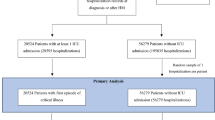Abstract
Post-thrombotic syndrome (PTS) has been associated to DVT recurrence, increased FVIII, inflammatory biomarker plasma levels, and persistence of vein obstruction. These same features have also been widely reported in non-O blood type subjects. Our aim was to investigate the correlation between the incidence of PTS and ABO blood types. Consecutive patients referred to the Department of Medicine of University of Padua between January 2004 and January 2012 following the diagnosis of a first episode of proximal DVT were enrolled. The presence of PTS was assessed via the Villalta scale at predefined time points (3, 6, 12, 18, 24, 36 months). Hazard ratio (HR) for PTS development was calculated in non-O (exposed) vs O blood (unexposed) type patients. Out of 671 eligible patients, 606 were enrolled. Overall, 192 (31.7%) patients developed PTS: 142 (34.5%) non-O and 50 (25.6%) O blood type patients. Individuals with non-O blood group were associated with a significantly higher risk to develop PTS (HR 1.53, 95% CI, 1.05–2.24; p = 0.028) than O group. Non-O blood type might be a risk factor for the development of PTS.

Similar content being viewed by others
References
Kahn SR, Comerota AJ, Cushman M, Evans NS, Ginsberg JS, Goldenberg NA, Gupta DK, Prandoni P, Vedantham S, Walsh ME, Weitz JI, American Heart Association Council on Peripheral Vascular Disease, Council on Clinical Cardiology, and Council on Cardiovascular and Stroke Nursing (2014) The postthrombotic syndrome: evidence-based prevention, diagnosis, and treatment strategies: a scientific statement from the American Heart Association. Circulation 130(18):1636–1661. https://doi.org/10.1161/CIR.0000000000000130
Prandoni P, Lensing AW, Cogo A, Cuppini S, Villalta S, Carta M, Cattelan AM, Polistena P, Bernardi E, Prins MH (1996) The long-term clinical course of acute deep venous thrombosis. Ann Intern Med 125(1):1–7. https://doi.org/10.7326/0003-4819-125-1-199607010-00001
Bittar LF, Paula EV, Montalvão SA, Mello TB, Annichino-Bizzacchi JM (2013) Severe post-thrombotic syndrome is associated with higher levels of factor VIII. Clin Appl Thromb Hemost 19(5):570–573. https://doi.org/10.1177/1076029612462760
Rabinovich A, Cohen JM, Kahn SR (2015) Predictive value of markers of inflammation in the postthrombotic syndrome: a systematic review: inflammatory biomarkers and PTS. Thromb Res 136(2):289–297. https://doi.org/10.1016/j.thromres.2015.06.024
Prandoni P, Frulla M, Sartor D, Concolato A, Girolami A (2005) Vein abnormalities and the post-thrombotic syndrome. J Thromb Haemost 3(2):401–402. https://doi.org/10.1111/j.1538-7836.2004.01106.x
Vasan SK, Rostgaard K, Majeed A, Ullum K, Titlestad KE, Pedersen OBV, Erikstrup C, Nielsen KR, Melbye M, Nyrén O, Hjalgrim H, Edgren G (2016) ABO blood group and risk of thromboembolic and arterial disease: a study of 1.5 million blood donors. Circulation 133(57):1449–1457. https://doi.org/10.1161/CIRCULATIONAHA.115.017563
Souto JC, Almasy L, Muniz-Diaz E, Soria JM, Borrell M, Bayén L, Mateo J, Madoz P, Stone W, Blangero J, Fontcuberta J (2000) Functional effects of the ABO locus polymorphism on plasma levels of von Willebrand factor, factor VIII, and activated partial thromboplastin time. Arterioscler Thromb Vasc Biol 20(8):2024–2028. https://doi.org/10.1161/01.ATV.20.8.2024
Kiechl S, Pare G, Barbalic M, Qi L, Dupuis J, Dehghan A, Bis JC, Laxton RC, Xiao Q, Bonora E, Willeit J, Xu Q, Witteman JCM, Chasman D, Tracy RP, Ballantyne CM, Ridker PM, Benjamin EJ, Ye S (2011) Association of variation at the ABO locus with circulating levels of soluble intercellular adhesion molecule-1, soluble P-selectin, and soluble E-selectin: a meta-analysis. Circ Cardiovasc Genet 4(6):681–686. https://doi.org/10.1161/CIRCGENETICS.111.960682
Dentali F, Di Minno MN, Turato S, Crestani S, Ambrosino P, Bonfanti C, Di Minno G, Ageno W, Franchini M (2014) Role of ABO blood group and of other risk factors on the presence of residual vein obstruction after deep-vein thrombosis. Thromb Res 134(2):264–267. https://doi.org/10.1016/j.thromres.2014.05.016
Spiezia L, Campello E, Giolo E, Villalta S, Prandoni P (2010) Thrombophilia and the risk of post-thrombotic syndrome: retrospective cohort observation. J Thromb Haemost 8(1):211–213. https://doi.org/10.1111/j.1538-7836.2009.03655.x
Schleef M, Strobel E, Dick A, Frank J, Schramm W, Spannagl M (2005) Relationship between ABO and secretor genotype with plasma levels of factor VIII and von Willebrand factor in thrombosis patients and control individuals. Br J Haematol 128(1):100–107. https://doi.org/10.1111/j.1365-2141.2004.05249.x
Roberts LN, Patel RK, Goss DE, Chitongo P, Bonner L, Arya R (2016) Relationship between development of post-thrombotic syndrome and serial ultrasound, D-dimer, and factor VIII activity after a first deep venous thrombosis. J Vasc Surg Venous Lymphat Disord 4(1):28–35. https://doi.org/10.1016/j.jvsv.2015.07.008
van Dongen CJ, Prandoni P, Frulla M, Marchiori A, Prins MH, Hutten BA (2005) Relation between quality of anticoagulant treatment and the development of the postthrombotic syndrome. J Thromb Haemost 3(5):939–942. https://doi.org/10.1111/j.1538-7836.2005.01333.x
Chitsike RS, Rodger MA, Kovacs MJ, Betancourt MT, Wells PS, Anderson DR, Chagnon I, LE Gal G, Solymoss S, Crowther MA, Perrier A, White RH, Vickars LM, Ramsay T, Kahn SR (2012) Risk of post-thrombotic syndrome after subtherapeutic warfarin anticoagulation for a first unprovoked deep vein thrombosis: results from the REVERSE study. J Thromb Haemost 10(10):2039–2044. https://doi.org/10.1111/j.1538-7836.2012.04872.x
Hull RD, Liang J, Townshend G (2011) Long-term low-molecular-weight heparin and the post-thrombotic syndrome: a systematic review. Am J Med 124(8):756–765. https://doi.org/10.1016/j.amjmed.2011.02.033
Baglin T (2012) Prevention of post-thrombotic syndrome: a case for new oral anticoagulant drugs or for heparins? J Thromb Haemost 10(8):1702–1703. https://doi.org/10.1111/j.1538-7836.2012.04806.x
Author information
Authors and Affiliations
Corresponding author
Ethics declarations
Conflict of interest
The authors declare that they have no conflict of interest.
Rights and permissions
About this article
Cite this article
Spiezia, L., Campello, E., Valle, F.D. et al. ABO blood group and the risk of post-thrombotic syndrome. Ann Hematol 97, 1057–1060 (2018). https://doi.org/10.1007/s00277-018-3255-3
Received:
Accepted:
Published:
Issue Date:
DOI: https://doi.org/10.1007/s00277-018-3255-3




